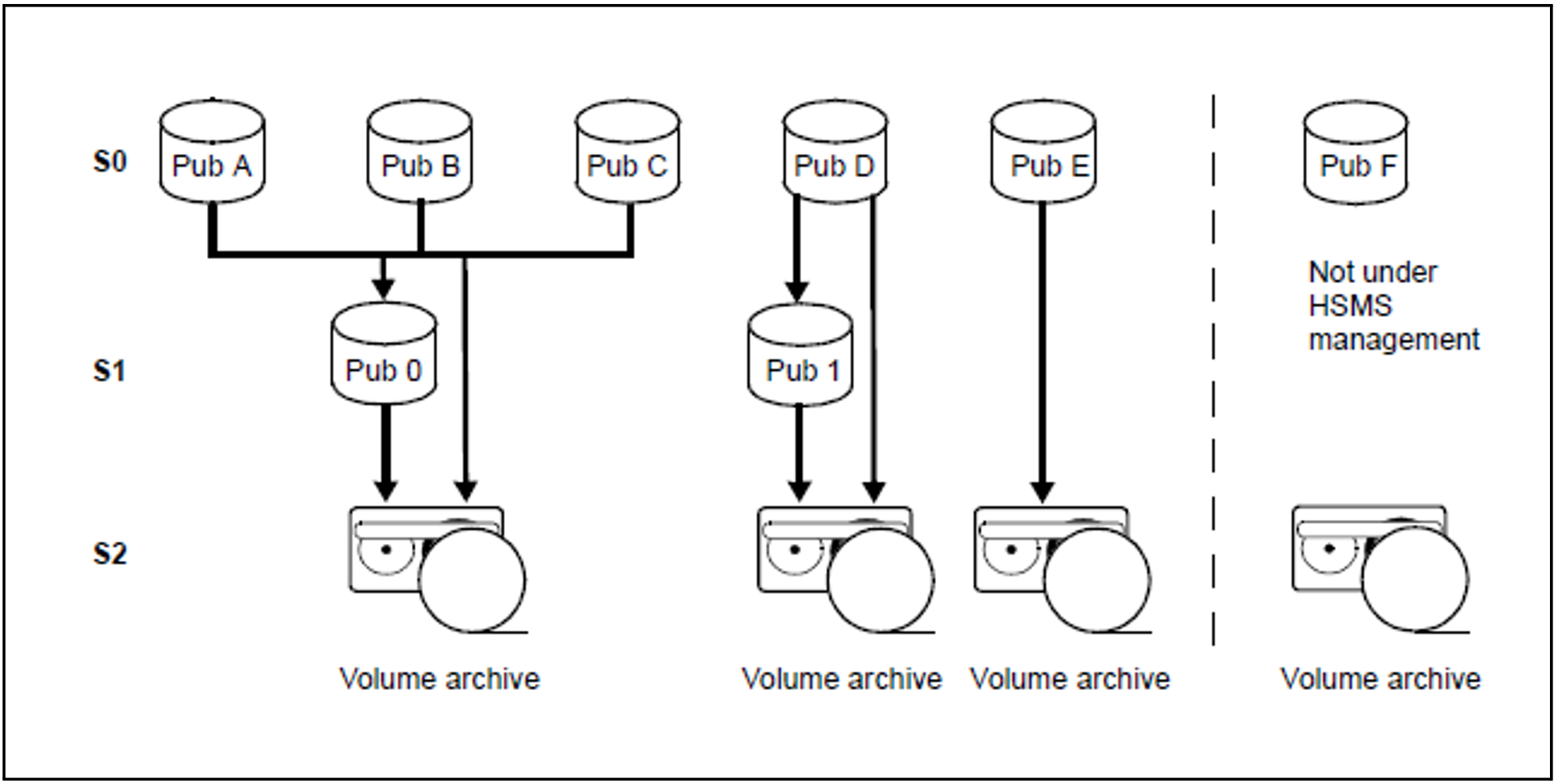HSMS implements migration in a three-level storage hierarchy which, among other features, offers support of both multiple public volume sets (MPVS, SF pubsets), shared SF pubsets, SM pubsets, and shared SM pubsets.
HSMS distinguishes between the three storage levels S0, S1, and S2, which are also addressed as such in the HSMS statements and BS2000 commands.
SF pubsets can be assigned either to processing level S0 or to storage or background level S1 depending on their properties such as availability, access time, and costs. The storage and background level S2 is implemented using tape media.
As far as HSMS is concerned, SM pubsets already have an internal storage hierarchy. But they can also be assigned as S1 level in the SF environment (S1-SM pubsets).
Net-Storage and private disks can be backed up and used for data saving under HSMS, but are not assigned to any of the storage levels.
Storage level S0
The S0 storage level is the normal processing level. It is implemented by pubsets which users can access online.
S0 is managed by the Data Management System (DMS). It is at this level that the data which can be handled using the basic HSMS functions is generated and processed.
If the system comprises disk storages with different characteristics, the high-speed disk storage types, i.e. the ones with short access times, should be assigned to storage level S0.
Storage level S1
The online background level S1 is also implemented by disk storages organized in SF pubsets, S1-SM pubsets, or volume sets of an SM pubset. The data on storage level S1 is managed by HSMS (HSMS files, of course, also being managed by DMS). It is to the S1 storage level that data from S0 is moved for migration.
High-capacity disk storages which can have longer access times than those on storage level S0, on which the data is stored at lower cost (to which compressed storage also contributes), are primarily assigned to storage level S1.
In the SF environment, storage level S1 can be assigned either globally for the entire system or specifically to individual S0 pubsets (see figure 1). It consists of one or more SF pubsets or S1-SM pubsets.
By contrast, in an SM pubset a volume set can be defined as S1 level. In HSMS V11.0 and higher, the S1 level can also be extended to all volume sets of the SM pubset which are under HSMS management. This extension is only possible in BS2000 OSD/BC V11.0 and higher. Irrespective of the number of volume sets available, the S1 level is only available in this SM pubset on a local pubset basis.
Storage level S1 is not mandatory in a system under HSMS management because the background level S2 is sufficient for standard HSMS operation.
Storage level S1 is not available for processing node files of the BS2000-UFS (POSIX) and remote nodes S0 mounted there.
Storage level S2
Storage level S2 consists of magnetic tape cartridges. The storage costs are considerably lower than for S0 and S1. On the other hand, operator or at least robot intervention is generally required to make level S2 data accessible. Access times for S2 storages are therefore of a different magnitude than those for the other storage levels.
S2 data can be used for migration. Optimum utilization of S2 volumes is achieved by “continuing” the magnetic tape cartridges.
The data on storage level S2 is managed by HSMS. HSMS allows the periods of time during which the volumes of storage level S2 may be processed to be defined on a function or archive-specific basis.
Overview of HSMS storage levels
storage level | Volume | Access | Access time |
S0 processing level | Disks | Online | Very short |
S1 background level | Disks | Online | Short |
S2 background level | Magnetic tape cartridges | Offline | Long |
The pubsets in a BS2000 configuration can be assigned to the various storage levels. For example, a pubset environment under HSMS management could look like this:
Figure 1: Example of a multiple public volume set under HSMS
In this example, the global S1 pubset 0 is assigned to pubsets A, B and C.
In contrast, the S1 pubset assigned to pubset D is pubset 1. Pubset E does not have an S1 pubset, which means that backups can be made only to S2.
One or more volume sets can be assigned to each SM pubset in a BS2000 configuration as an S1 storage level. If the SM pubset outside the S1 volume set is damaged and must be set up again, existing full volume sets can be integrated into the SM pubset reconfiguration.
In addition, an SM pubset can be set up as storage level S1 within the SF environment. To do this, it is placed under HSMS control as an SM pubset and then defined either globally like an SF pubset or as storage level S1 on a pubset-specific basis. For details, see section "Assigning an SM pubset to storage level S1".

